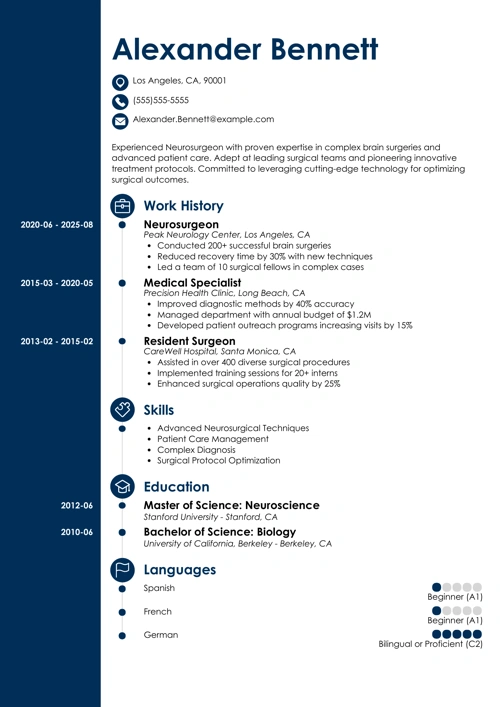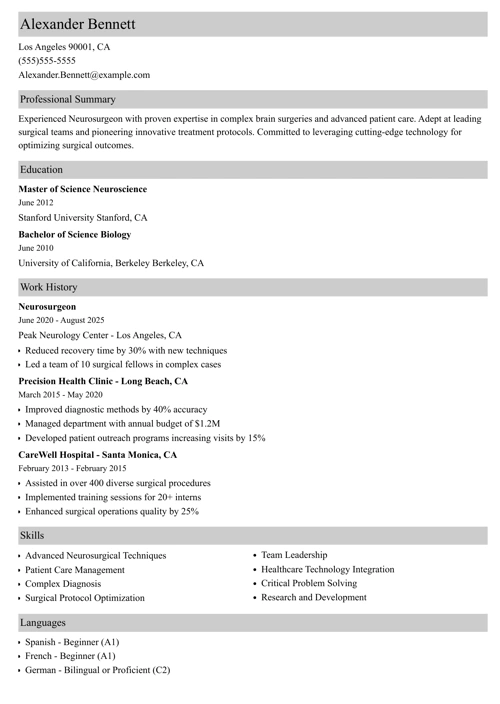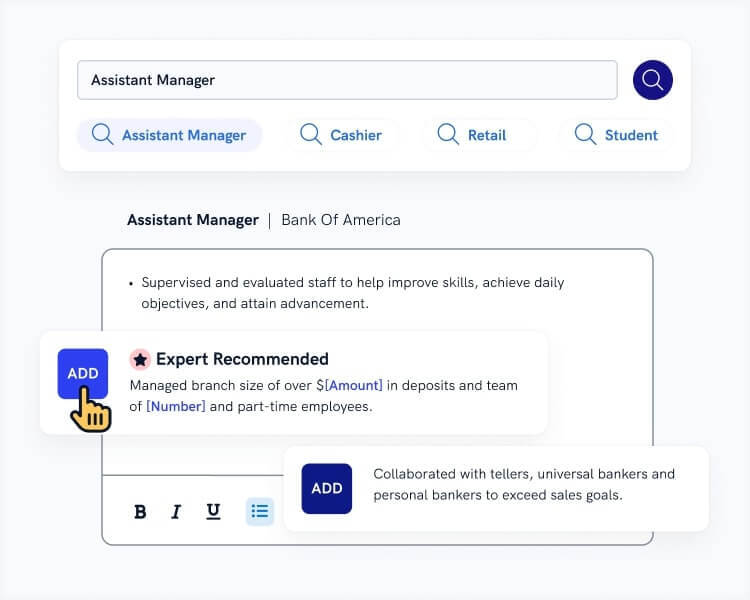Your neurosurgeon resume must exemplify your precision and expertise. This guide provides expert advice and neurosurgeon resume examples to help you effectively display your surgical proficiency, research accomplishments, and clinical successes. Let's begin your journey to the next career achievement.
This guide will show you:
- A neurosurgeon resume example that outshines 90% of other resumes.
- How to write a neurosurgeon resume that garners more interview opportunities.
- Tips and examples for highlighting skills and achievements on a neurosurgeon resume.
- How to present your experience on a neurosurgeon resume to secure your desired position.
Want to save time and have your resume ready in 5 minutes? Try our resume builder. It’s fast and easy to use. Plus, you’ll get ready-made content to add with one click. See 20+ resume templates and create your resume here.
Sample resume made with our builder—See more resume examples here.
If you're eager to explore more resume samples, you're in the right place:
- Medical Doctor Resume Example & Writing Guide
- Physician CV Example & Writing Guide
- Healthcare Professional Resume Example & Writing Guide
- Medical Resume Example & Writing Guide
- Physician Assistant Resume Example & Writing Guide
- Medical Resident CV Example & Writing Guide
- Clinical Research Coordinator Resume Example & Writing Guide
- Public Health Resume Example & Writing Guide
- Academic CV Example & Writing Guide
- Resume Examples & Writing Guides for All Jobs
Neurosurgeon Resume Example
Dr. Alexander Bennett, MD, FAANS
Neurosurgeon
(555) 789-6543
alexander.bennett@email.com
linkedin.com/in/dr-alexander-bennett
Summary
Board-certified Neurosurgeon with 12+ years of experience diagnosing and performing advanced surgical procedures for brain, spine, and peripheral nerve disorders. Skilled in minimally invasive techniques, complex tumor resections, and neurotrauma care. Committed to delivering patient-centered care and improving neurological outcomes through precision surgery and collaborative treatment plans. Eager to bring expertise in neurosurgical innovation to Johns Hopkins Hospital.
Experience
Neurosurgeon
Northwest Neurology Center, Seattle, WA
July 2014–January 2025
Key Qualifications & Responsibilities
- Performed over 500 complex neurosurgical procedures, including craniotomies, spinal decompressions, and microvascular surgeries.
- Diagnosed and treated patients with neurological disorders, including brain tumors, aneurysms, spinal stenosis, and epilepsy.
- Collaborated with neurologists, oncologists, and radiologists to develop multidisciplinary care plans tailored to patient needs.
- Utilized advanced imaging techniques, including MRI and CT scans, to guide precision surgical interventions.
Key Achievement:
- Implemented a minimally invasive spine surgery program, reducing patient recovery times by 30% and increasing referrals by 20%.
Neurosurgical Fellow
University Medical Center, San Francisco, CA
July 2012–June 2014
Key Qualifications & Responsibilities
- Assisted in complex brain and spinal surgeries, gaining hands-on expertise in cutting-edge neurosurgical techniques.
- Conducted clinical research on glioblastoma treatments, presenting findings at national neurology conferences.
- Managed preoperative and postoperative patient care, ensuring seamless recovery and continuity of care.
Key Achievement:
- Published research on advanced techniques for intracranial aneurysm repair in a leading peer-reviewed journal.
Education
Doctor of Medicine (MD)
Harvard Medical School, Boston, MA
September 2006–June 2010
Bachelor of Science in Neuroscience
Stanford University, Stanford, CA
September 2002–May 2006
Skills
- Advanced Neurosurgical Techniques (Minimally Invasive & Open Procedures)
- Tumor Resections & Microvascular Surgery
- Neurological Diagnosis & Imaging Analysis (MRI, CT)
- Spine Surgery (Decompressions, Fusions)
- Neurotrauma Care
- Patient Education & Counseling
- Research & Clinical Trials
- Interdisciplinary Collaboration
Certifications and Licenses
- Board Certified in Neurological Surgery, American Board of Neurological Surgery, 2016
- Fellow, American Association of Neurological Surgeons (FAANS), 2017
- Advanced Cardiovascular Life Support (ACLS), American Heart Association, current
- Basic Life Support (BLS), American Heart Association, current
- Medical License: State of Washington, License No. MD123456
Awards
- Neurosurgeon of the Year, American Association of Neurological Surgeons, 2020
- 2018, Excellence in Patient Care, NeuroHealth Institute
Memberships
Member of the American Association of Neurological Surgeons since 2012
- Presented findings on neuroplasticity at the 2019 Annual Scientific Meeting
- Contributed to the development of new surgical guidelines for spinal disorders
Languages
- English—Native
- Spanish—Fluent
Interests
- Volunteering in medical missions to provide neurosurgical care in underserved regions
- Writing articles on advancements in neurosurgery for medical journals and blogs
Here’s how to write your own neurosurgeon resume:
1. Format Your Neurosurgeon Resume Correctly
Your neurosurgeon resume must captivate and engage from the start. With the competitive nature of the field, a well-organized resume format that is visually appealing can make all the difference.
To structure your resume for neurosurgeon roles:
- Begin with a resume header that includes your name, phone number, email, LinkedIn profile, and any relevant online portfolio links. These are the essential contact details to include on your resume.
- While your street address isn't necessary, mention your city if it aligns with the company's location.
- Opt for a reverse-chronological resume format, placing your most recent position at the top. This is the preferred resume layout for hiring managers.
- Select a professional resume font like Calibri or Arial, keeping the font size between 10 and 12 points.
- Label your resume file as “Your Name - Neurosurgeon - Resume.pdf.” A PDF resume file is advantageous as it preserves the layout.
- The optimal resume length for entry-level positions is one page. However, a two-page resume or more may be appropriate if you have extensive achievements.
Add the perfect finishing touch with well-chosen resume icons: Guide to Resume Icons
2. Customize Your Neurosurgeon Job Description
The Bureau of Labor Statistics projects that employment for physicians and surgeons will grow by 4% between 2023 and 2033, matching the average growth rate for all occupations. To stand out in this competitive field, highlight your medical expertise, patient care accomplishments, and specialized training in a well-structured work experience section.
Tailoring your resume to the specific role is vital; a generic list of duties often falls flat. When hiring managers encounter a mundane set of responsibilities, they might question the candidate's true impact.
Here's how to highlight relevant experience effectively:
- Incorporate the job title from the posting to enhance ATS compatibility.
- Following the company name and employment period, add 3–6 bullet points to illustrate your recent roles.
- Highlight your strengths with measurable professional accomplishments and performance metrics.
- Start each point with strong action verbs like orchestrated, innovated, and executed.
Neurosurgeon Resume Examples: Responsibilities
- Conduct intricate surgical procedures on the brain, spine, and nervous system with precision.
- Partner with interdisciplinary teams to develop comprehensive patient care plans.
- Perform in-depth diagnostic evaluations to assess surgical needs.
- Keep abreast of cutting-edge neurosurgical techniques and technologies.
- Mentor medical residents and fellows in neurosurgical practices.
- Engage in clinical research to advance the field of neurosurgery.
- Follow hospital protocols and safety regulations during surgeries.
Remember to use action verbs that convey your responsibilities and achievements effectively. Here are some action verbs for neurosurgeon resumes:
Neurosurgeon Resume Examples: Action Verbs
- Performed
- Diagnosed
- Operated
- Collaborated
- Directed
- Innovated
- Implemented
- Evaluated
- Consulted
- Researched
Convey your enthusiasm effectively: Resume Synonyms: Excited
3. Make Your Education Section Count
Listing your educational achievements is customary, but sticking to the basics—degree, school, and dates—can be as limiting as using advanced software for simple tasks. To stand out, emphasize your education to showcase additional skills, enhancing your chances of landing interviews.
Consider these resume tips:
- Feature your academic qualifications immediately after your work experience for maximum impact.
- For those just starting, highlight relevant coursework to demonstrate your capabilities.
- Even on seasoned resumes, include bullet points for fellowships, scholarships, or leadership roles you've undertaken.
- Debating whether to include your GPA? Find out when to list your GPA on a resume. If it impresses, showcase it.
Find empowering job opportunities for people with disabilities that leverage unique strengths: Jobs for People with Disabilities
Creating a resume with our builder is incredibly simple. Follow our step-by-step guide and use content from Certified Professional Resume Writers to have a resume ready in minutes.
When you’re done, Zety’s resume builder will score your resume and our resume checker will tell you exactly how to make it better.
4. Prove the Neurosurgeon Resume Skills the Company Wants
Incorporating skills on a resume is necessary, but there's a strategic way to do it. You know you need a concise list of 5–10 essential neurosurgeon skills. But—randomly picking them won't cut it. Instead, focus on the most critical skills highlighted in the job listing.
Here's how to integrate neurosurgeon skills into a resume:
- The skills mentioned in the ad are your resume keywords. Incorporate them into your resume's shortlist.
- Avoid listing an excessive number of skills (like 20). Doing so may cause the important ones to get overlooked.
- To maximize interview opportunities, ensure the skills listed also appear in your job and education bullet points.
Here are some hard and soft skills for a resume for neurosurgeons:
Neurosurgeon Resume Skills
- Neurosurgical Techniques
- Microsurgical Expertise
- Preoperative and Postoperative Care
- Advanced Imaging Interpretation
- Neuroanatomy and Physiology
- Tumor Resection and Spinal Surgery
- Minimally Invasive Procedures
- Research and Clinical Trials
- Robotic Surgery Proficiency
- Emergency Trauma Response
- Interpersonal Skills
- Verbal and Written Communication Skills
- Leadership Skills
- Organizational Skills
- Active Listening
- Problem-Solving Skills
- Time Management Skills
- Attention To Detail
- Stress Management
- Teamwork Skills
- Computer Skills
- Adaptability
Stand out with creative thinking skills that demonstrate your innovative potential: Explore Here
5. Add Other Sections to Your Neurosurgeon Resume
“The resume is impressive—but is this neurosurgeon a good fit for our team?” Hiring managers look beyond credentials—they want to know your stamina, leadership, and ability to handle high-pressure situations. Adding extra sections to your resume can showcase your dedication, surgical expertise, and contributions to the field, helping you stand out as a top candidate.
Here are a few added sections that can show your strengths:
- Professional Certifications: Highlight board certifications like ABNS certification or specialized fellowships in vascular, pediatric, or spine surgery.
- Publications & Research: List contributions to medical journals or clinical studies to showcase expertise and thought leadership.
- Professional Associations: Memberships in AANS, CNS, WFNS, or your country’s neurosurgical society demonstrate industry engagement.
- Teaching & Mentorship: If you train residents, speak at conferences, or contribute to medical education, include this to reflect leadership.
- Volunteer Work: Participation in medical missions, neurosurgical outreach programs, or pro bono surgeries shows commitment beyond the OR.
Explore why "References available upon request" is a crucial line and how it can impact your resume's effectiveness: References Available Upon Request
6. Write a Neurosurgeon Resume Objective or Resume Summary
To catch a hiring manager's attention in the brief moments they spend on each application, your resume introduction needs to shine. According to our HR statistics report, resumes typically receive only a fleeting glance of 6 to 7 seconds. Capture their interest with a powerful introduction that highlights your key qualifications.
Think of this as your resume profile — akin to an elevator pitch but more succinct. Aim to deliver a compelling one-paragraph summary within that critical seven-second window.
For those with at least a year of experience, include this in your introduction along with your current job title, how you can benefit the facility, and a couple of notable achievements. This approach, known as a resume summary, should be prominently positioned at the top of your resume.
If you're writing a neurosurgeon’s resume with little to no experience, focus on your academic achievements, clinical rotations, and research contributions. In this case, your introduction should be a resume objective, highlighting your medical education, surgical training, and passion for neurosurgery. Tailoring this section to emphasize your skills and commitment can help you stand out as a strong candidate.
Learn how to present yourself with confidence and precision by mastering How to Describe Yourself in interviews and resumes.
7. Write a Cover Letter for Your Neurosurgeon Resume
In today's job market, cover letters are essential. Many applicants indiscriminately send resumes to multiple job listings. A thoughtful cover letter demonstrates your genuine interest in a specific company and role, setting you apart.
Craft your cover letter like this:
- Employ a professional cover letter structure: using the same header as your resume and closing with a business-appropriate signoff.
- Adhere to a concise cover letter format: three to five paragraphs, keeping it under a page.
- Initiate with an engaging cover letter opener: mention the job title and add a captivating sentence to draw them in.
- Use the middle paragraphs to elaborate on your top neurosurgeon achievements.
- Conclude your cover letter effectively: highlight additional skills and request a discussion about how you can contribute.
- Follow up with a short follow-up email weekly for a month, attaching your resume and cover letter in PDF format.
Discover how to write a compelling letter of application that stands out: Letter of Application
Plus, a great cover letter that matches your resume will give you an advantage over other candidates. You can write it in our cover letter builder here. Here's what it may look like:
See more cover letter templates and start writing.
Begin your journey toward a rewarding neurosurgery position with a resume that truly reflects your skills and aspirations.
About Zety’s Editorial Process
This article has been reviewed by our editorial team to make sure it follows Zety's editorial guidelines. We’re committed to sharing our expertise and giving you trustworthy career advice tailored to your needs. High-quality content is what brings over 40 million readers to our site every year. But we don't stop there. Our team conducts original research to understand the job market better, and we pride ourselves on being quoted by top universities and prime media outlets from around the world.




